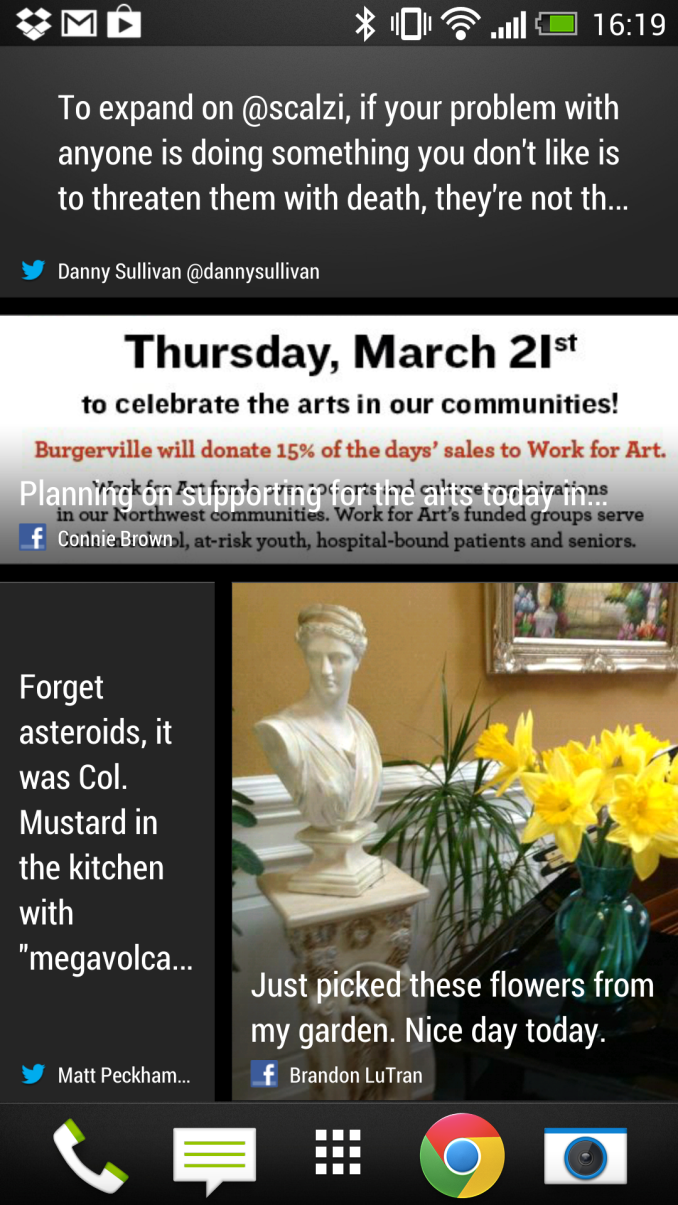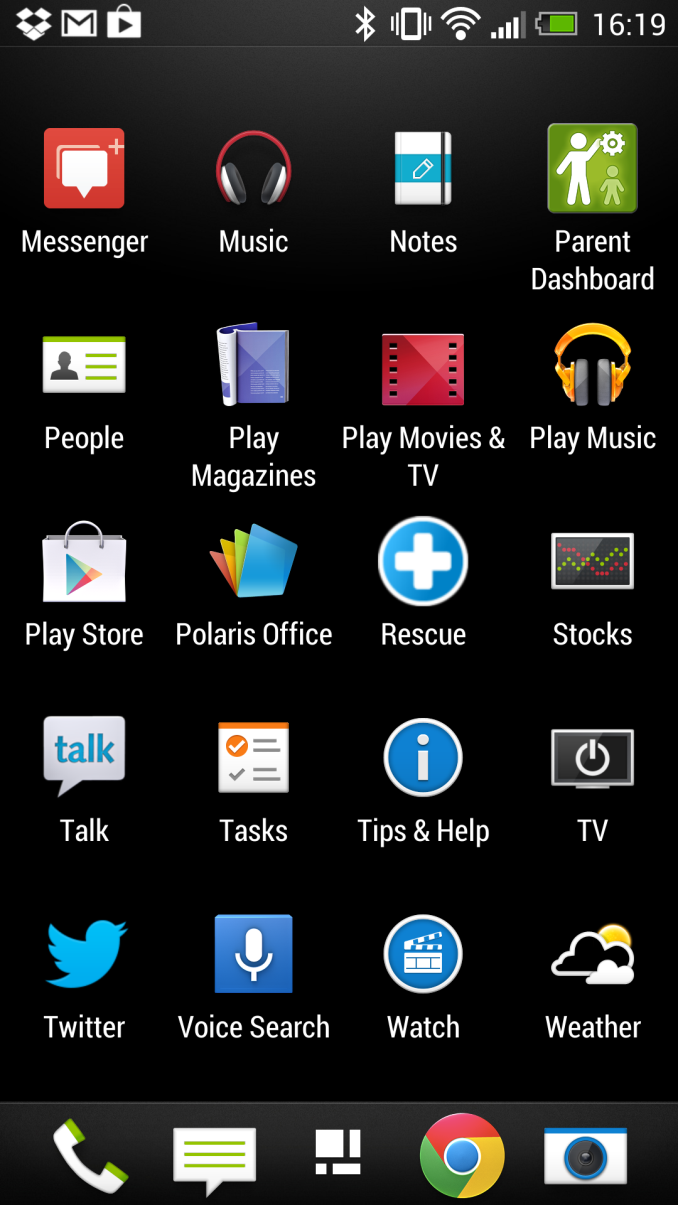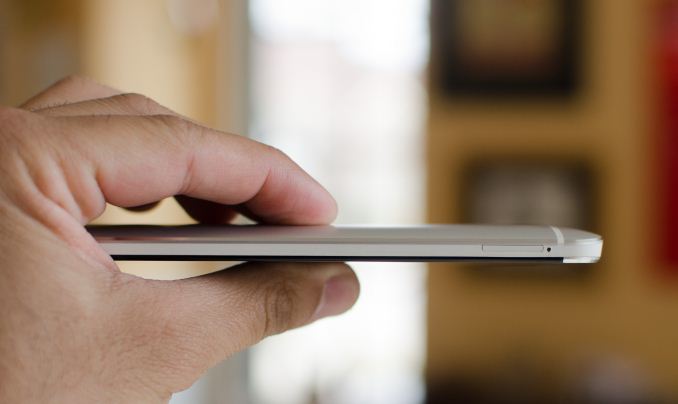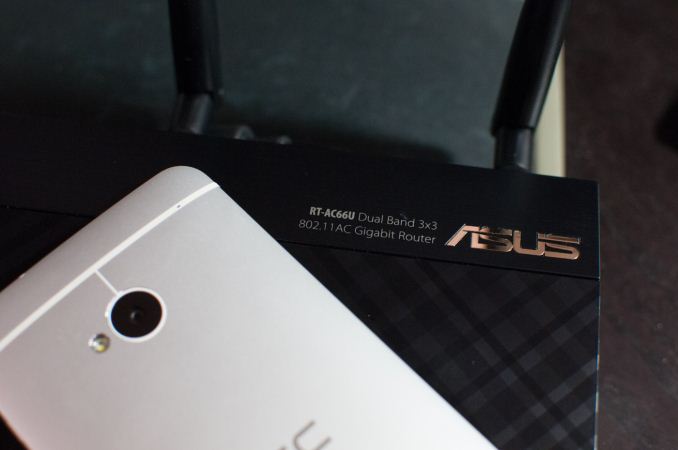The HTC One: A Remarkable Device, Anand’s mini Review
by Anand Lal Shimpi on March 21, 2013 4:49 PM EST- Posted in
- Smartphones
- HTC
- Mobile
- HTC One
Android/Sense
The One ships with Sense 5.0, and I have to say that the latest version of Sense is really the first custom Android skin that I don’t mind. I’m not sold on Blinkfeed, the default homescreen that allows you to aggregate content from multiple web sources as well as Twitter and Facebook, but thankfully you can easily change that default to something more traditionally Android.
With Sense 5.0 HTC dramatically reduced the presence of widgets on the default home screen. Other than the Blinkfeed screen, there’s only a single home screen by default and the only widget on that screen is a Google search box. You can obviously add all of the widgets you want, but this is a noticeable departure from HTC’s strategy in the past. To be honest, it’s a lot cleaner.
Sense 5.0 isn’t intrusive, and the work HTC has done in the gallery app sort of make the customizations worth it (more on this later). Even the default pre-load of apps is very sensible.
Thanks to the underlying use of Android 4.1.2 combined with the fast Snapdragon 600 SoC, UI frame rate is incredibly smooth. Some interactions are still not perfect (e.g. zooming in Google Maps) but the overall experience is very polished and very fast.
Performance & Battery Life
The One is the first Snapdragon 600 based smartphone that I’ve used regularly. For those who aren’t familiar with Qualcomm’s latest branding change, Snapdragon 600 refers to a quad-core Krait 300 based SoC with Adreno 320 graphics (APQ8064T). The SoC still uses the same 28nm LP process as the previous quad-core flagship (APQ8064), but clocks are a bit higher (1.7GHz in the One, 1.9GHz in the Galaxy S 4).
GPU clocks appear unchanged, which is contrary to what I was told at the launch of Krait 300 but it’s entirely possible that we’ll see implementation with higher GPU clocks.
Performance, as I mentioned before, is very good. Even the speed of the NAND HTC used in the device is among the best I’ve seen in Android devices. We’re still not yet at the point where I believe smartphone SoC performance is good enough, but at least we won’t see a huge jump in SoC performance (at similar power) until the move to 20nm in mid to late 2014.
The impact of all of this on battery life, as always, depends on your usage model. I’ve been using the international One on AT&T, and 3G battery life is comparable to the iPhone 5 on the same network (non-LTE) at identical brightness levels. I have yet to see what the difference will be like with LTE enabled.
Obviously with four cores and a larger, higher resolution display, the One definitely has the ability to draw more power than the iPhone 5. Keep the cores more active and/or drive the display at very high brightness levels and you’ll see worse battery life. For the past couple of years I’ve been talking about the increase in dynamic range when it comes to smartphone battery life, the One is no different in this regard. Brian will have a full rundown of battery life data on the One in his review.
Other Frills: Of Big Screens and Usability
For me, the iPhone 5’s display is a little too small, and the One is probably a little too big. I think I agree with Brian here in that the ideal display size is somewhere around 4.3”. That being said, I find both devices (the 5 and the One) to be comfortably usable. The 5 is better for one handed use, while the One is better for actually consuming web content. In pocket, the One is thin enough to not be a problem.
Although it’s probably a bit overkill, I am pleased with the move to 1080p across all of the high end Android smartphones. The One’s display looks excellent and lacks the oversaturated colors of the alternative AMOLED displays.
The One also features stereo speakers that get impressively loud (louder than any other smartphone I’ve used, by a considerable margin). I keep my phone on silent all the time but when showing others highlights reels, the One’s loud stereo speakers definitely come in handy.
The final element of the One that I’m really happy about is the integration of 802.11ac support. The One is good for WiFi speeds of up to 275Mbps (that’s actually tested, not theoretical).














434 Comments
View All Comments
Samus - Thursday, March 21, 2013 - link
I've never owned an HTC phone, but now maybe I will. In the past, friends have complained about things from random reboots to cheap plastic. I have a Galaxy S3 and planned to hang on to it for awhile but hey, at least its held its value if I decide to sell it.And considering I never capture photo's at max resolution on ANY of my camera's (even my DSLR) I could care less it's a 4MP sensor. I usually capture at 3.1MP anyway.
CeriseCogburn - Friday, March 22, 2013 - link
Oh that's weird. you must have a tiny computer screen 1024X768. Upgrade your monitor so your old crappy DSLR can be upgraded too.Stop living in the past. 3.1 mp ? LOL
You will never get hired for camera work.
evonitzer - Friday, March 22, 2013 - link
I hesitate to even respond to your trolling comments (which have been all over this thread article. Where do you find the time?) but do the math. 1920x1080 is 2 mp. Therefore, for full screen viewing you don't need anything more than that. 1024x768 is .78mp.The only time you need more is if you own a 4k television (8.3mp) and you have way too much money, or you are printing. But who prints cell phone pics? Who prints anything for that matter?
But if you must, an 8x10 can be made with a 4mp picture using 204dpi, which is ok.
snajk138 - Sunday, March 24, 2013 - link
You're forgetting about cropping and zooming. If I take an 8MP shot I can cut out the 75% of the image that I don't need and still get the "full" resolution of my HD screen. If I'm showing a picture to someone I tend to zoom in on the important stuff. Doing both means I might actually need th 13MP or whatever that some new phones have.Not that MP's say much about picture quality anyway and they're getting to the point where more pixels actually means worse quality, but still, higher resolutions are not a waste just because we don't have as high a resolution displays.
CeriseCogburn - Monday, March 25, 2013 - link
Thank you, I was going to tell DUMMY to pinch and zoon into his brain, he may find the second cell.evonitzer - Monday, March 25, 2013 - link
I wasn't forgetting, I was making your second point. I'm all for argument for its own sake, but seriously! We agree! More pixels are not a waste if they are actually contributing, but having pinch-zoomed on my cell phone pics I have pretty serious doubts there is much extra info to be gained.I have less to agree with Cerise though. 76 comments! Are you serious?! I really hope you are getting paid by somebody.
pandemonium - Thursday, March 21, 2013 - link
It's cool hearing your endorsing experience with it. On paper and theory this phone appears to be the next big thing out there and it's great hearing first-hand that at least some of that is true.Looking forward to Brian's extensive breakout!
darwinosx - Friday, March 22, 2013 - link
Really disappointing that this phone will not be on Verizon., I can't understand their reasoning for this unless they somehow think the DNA is an acceptable substitute. It isn't.Silma - Friday, March 22, 2013 - link
It would be nice if HTC did a WP8 One.Regarding removable batteries I'm still changing batteries after 18-24monthes. Not replacing my phone every year I still think it's a must.
Same thing for ultrabooks / tablets really. That's why I still haven't bought a Surface Pro or an Ultrabook. I don't want a 45min autonomy device in 2 years because I can't replace the battery.
delica - Friday, March 22, 2013 - link
Anand,One thing I've noticed is how much smoother and more responsive devices using Snapdragon processors are than those using Tegra. Tegra always makes for a choppy Android UI, regardless of how many cores you are running or the clock speed. Interestingly, even phones running android 2.3 on Snapdragon S2 feel smoother than my Samsung S2. Though I'm actually not sure now whether my S2 has an Exynos or an Nvidia CPU, but the gist of it is the same. My Asus Infinity has Tegra 3 and Android 4.1 and is still extremely choppy.
So, my question is whether you, or anyone else here for that matter, are under the same impression?